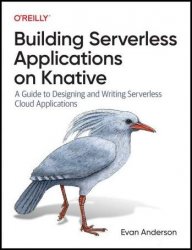Building Serverless Applications on Knative: A Guide to Designing and Writing Serverless Cloud Applications
- Добавил: literator
- Дата: 16-02-2024, 07:26
- Комментариев: 0
 Название: Building Serverless Applications on Knative: A Guide to Designing and Writing Serverless Cloud Applications
Название: Building Serverless Applications on Knative: A Guide to Designing and Writing Serverless Cloud ApplicationsАвтор: Evan Anderson
Издательство: O’Reilly Media, Inc.
Год: 2024
Страниц: 252
Язык: английский
Формат: pdf (true), epub (true)
Размер: 10.3 MB
Explore the theory and practice of designing and writing serverless applications using examples from the Knative project. With this practical guide, mid-level to senior application developers and team managers will learn when and why to target serverless platforms when developing microservices or applications. Along the way, you'll also discover warning signs that suggest cases when serverless might cause you more trouble than joy.
Drawing on author Evan Anderson's 15 years of experience developing and maintaining applications in the cloud, and more than 6 years of experience with serverless platforms at scale, this book acts as your guide into the high-velocity world of serverless application development. You'll come to appreciate why Knative is the most widely adopted open source serverless platform available.
With this book, you will:
• Learn what serverless is, how it works, and why teams are adopting it
• Understand the benefits of Knative for cloud native development teams
• Learn how to build a serverless application on Knative
• Explore the challenges serverless introduces for debugging and the tools that can help improve it
• Learn why event-driven architecture and serverless compute are complementary but distinct
• Understand when a serverless approach might not be the right system design
Who Is This Book For?
The primary audience for this book is software engineers and technologists who are either unfamiliar with serverless or are looking to deepen their understanding of the principles and best practices associated with serverless architecture.
New practitioners who want to immediately dive into writing serverless applications can start in Chapter 2, though I’d recommend Chapter 1 for additional orientation on what’s going on and why serverless matters. Chapter 3 provides additional practical material to develop a deeper understanding of the architecture of the Knative platform used in the examples.
The order of the chapters should be natural for readers who are familiar with serverless. Chapters 5 and 6 provide a checklist of standard patterns for applying serverless, while Chapter 8 and onward provides a sort of “bingo card” of serverless warning signs and solution sketches that may be handy on a day-to-day basis. Chapter 11’s historical context also provides a map of previous technology communities to examine for patterns and solutions.
For readers who are more interested in capturing the big-picture ideas of serverless, Chapters 1, 4, and 7 have some interesting gems to inspire deeper understanding and new ideas. Chapter 11’s historical context and future predictions may also be of interest in understanding the arc of software systems that led to the current implementations of scale-out serverless offerings.
For readers who are new not only to serverless computing, but also to backend or cloud native development, the remainder of this preface will provide some background material to help set the stage. Like much of software engineering, these areas move quickly, so the definitions I provide here may have changed somewhat by the time you read this book. When in doubt, these keywords and descriptions may save some time when searching for equivalent services in your environment of choice.
Скачать Building Serverless Applications on Knative: A Guide to Designing and Writing Serverless Cloud Applications
Внимание
Уважаемый посетитель, Вы зашли на сайт как незарегистрированный пользователь.
Мы рекомендуем Вам зарегистрироваться либо войти на сайт под своим именем.
Уважаемый посетитель, Вы зашли на сайт как незарегистрированный пользователь.
Мы рекомендуем Вам зарегистрироваться либо войти на сайт под своим именем.
Информация
Посетители, находящиеся в группе Гости, не могут оставлять комментарии к данной публикации.
Посетители, находящиеся в группе Гости, не могут оставлять комментарии к данной публикации.
